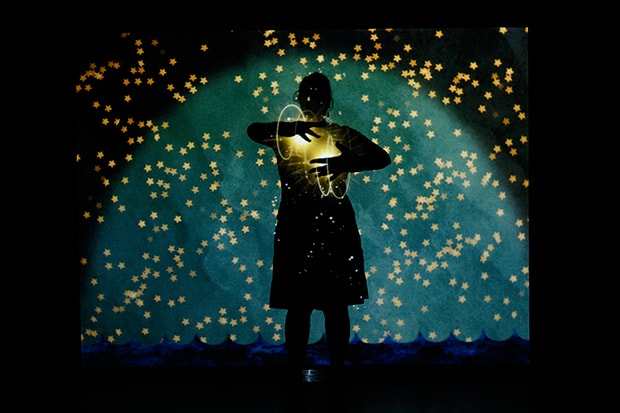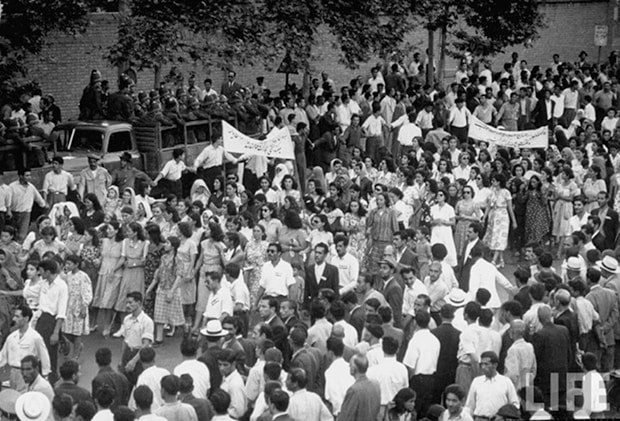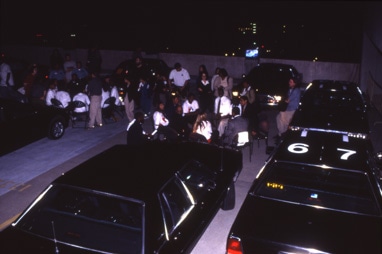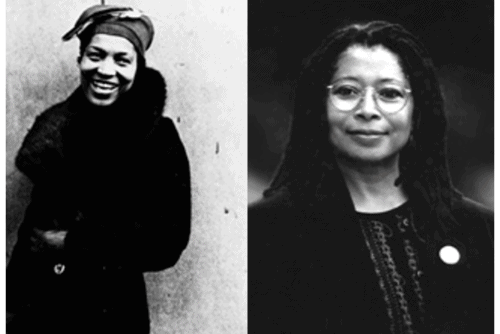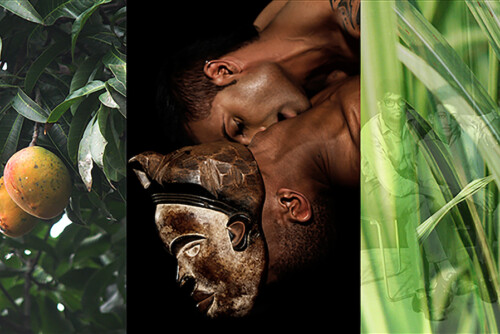Physical cinema as a curatorial practice—and its implications for feminist work—can be recognized in four pieces curated for New Frontier. In January 2011, American animator Miwa Matreyek gave two performances at New Frontier: Dreaming of Lucid Living and Myth and Infrastructure. The performances consisted of a screen with front and rear projection with the shadow and silhouette of her body moving through animated dense cityscapes, primal fantastical realms, natural environments, and domestic spaces. Inspired by collaborations with Chi-wang Yang and Anna Oxygen, fellow members of the multimedia group Cloud Eye Control, Matreyek’s interdisciplinary practice experiments with emerging technologies and brings together media of performance, animation, theater, video installation, sculpture, dance, and music. Matreyek integrates strategically overlapping projections of her own animation with precisely choreographed movement of her body, effectively juxtaposing what she refers to as “illusion and nonillusion.”41
4 minute excerpt of Miwa Matreyek performance, Myth and Infrastructure (2010). Courtesy the artist, copyright the artist.
The work relies on two parallel narratives: the audience’s reckoning of how a “live” body is positioned in relation to the animation and cinematic composition of the projections, and nonlinear animated stories that simultaneously evoke epic tales of the evolution of the human species and offer an oracle of sorts for the future.42 In one three-minute sequence from Myth and Infrastructure, Matreyek’s silhouette enters the frame, flora spring up with each of her giant steps in a tiny, growing forest. Creation stirs through her fingertips, swirling a starry night sky around her body, framed by a full moon. Her hands call forth water, and she bends down to transform her back into an island in the ocean. Inside her chest, a nestled egg spins like a magical atom, propelling sparks through her throat, and out of her mouth comes a tiny woman. She scoops the woman out of the ocean, placing her onto the island that is her back. Schools of fish and whales swim through and past the shadow of Matreyek’s body—now almost indistinguishable as a “real” body in the rich landscape projected on the front and back of the screen. Pine trees grow tall on the island, until, shortly after the discovery of fire, they burn, birds flee, and deer are killed. A large wave washes over the island; a single survivor remains. Matreyek’s shadow rises up from the ocean—mother of creation—and she faces this tiny, lone woman.
Lorde’s theory of the erotic as “a measure between the beginnings of our sense of self and the chaos of our strongest feeling” resonates with how Matreyek articulates the distinction between the meaning made from her body’s performance and another’s body.43
I am both me and anonymous. If I put someone else in my videos or as a performer, I feel like I have to deal with a lot more about that person’s gender, history, age, appearance, physical presence and movement … and that changes my work … my body is the most direct [route] from imagination to reality.44
Bringing the specificity of one’s own body to bear on what and how one knows, the erotic is a crucial part of how Matreyek conceptualizes her artistic work and practice.
Australian artist Lynette Wallworth’s installation piece at the 2009 edition of New Frontier, Evolution of Fearlessness explores the limits of connectivity between the screen and the body through the deliberate acts of gesture and touch. The visitor enters the installation room, completely darkened but for two spots of light. Treading carefully without being able to see what lies ahead, the visitor is beckoned toward the first light at the side of the room. A reading station illuminates written texts documenting the personal experiences and journeys of 11 women currently residing in Australia after seeking asylum as political refugees from Afghanistan, Sudan, Iraq, and El Salvador. Venturing toward the second light glowing at the far end of the room, the visitor is moved to place their palm against the light in the middle of a full-length video screen. The room illuminates slightly and a figure moves forward from the darkened depths of the frame—she is a filmed portrait of one of the 11 women whose stories the visitor just read. The randomness built into the system is designed so the visitor cannot predict or control which woman they will encounter. As the woman approaches, she looks directly toward the visitor before raising her palm to meet theirs. One imagines they might be touching if it weren’t for the screen. Eyes locked, background black, and no verbal exchange, there is little sense of geography or time. Wallworth’s piece foregrounds the influence of sharing presence and is designed so that each woman indicates she is ready to leave through eye contact before translating it into gesture. Held in a heightened empathetic state, the visitor reads this intention and often releases their hand at the same time as the woman.
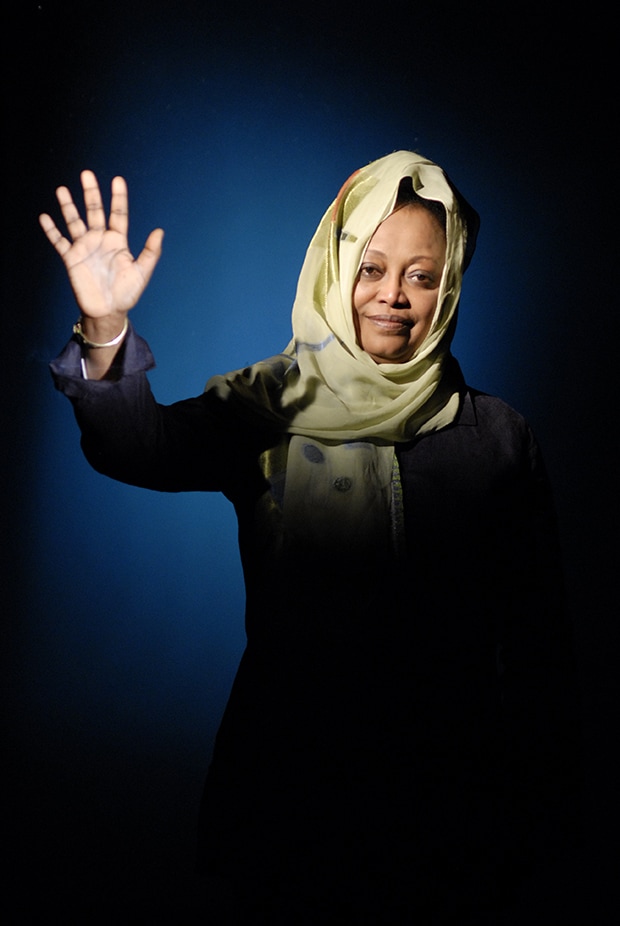
Wallworth sought to interrupt the fear-mongering political rhetoric used to elicit xenophobic reactions toward people seeking immigration and asylum in Australia in 2008. Wallworth explains: “It’s very difficult to confront these fear tactics once they become mediated, but it’s a very different thing to look someone in the eyes and maintain those prejudices.”45 The perceptual interface of Evolution of Fearlessness enables a responsive environment that asks for intimacy from the viewer, starting from the darkness of the installation space. As with her other works, Wallworth views “non-threatening (comfortable) darkness as a space where transformation occurs.”46 This transformation is through the viewer’s physical movement, initiated through a deliberate gesture that manifests in the appearance of a life-sized projection reflective of their own body.
Wallworth’s piece engages with an understanding of the erotic further theorized in Laura Marks’ discussion of haptic visuality. Haptic cinema, Marks writes, “involves thinking with your skin, or giving as much significance of the physical presence of an other as to the mental operations of symbolization.” Marks is careful to distinguish the possibilities of haptic cinema from an approach to cinema that feeds the “desire to lose yourself in other people’s lives” by overwhelming the viewer with the moving image. She writes:
This is not a call to willful regression but to recognizing the intelligence of the perceiving body. Haptic cinema, by appearing to us as an object with which we interact rather than an illusion in which we enter, calls on this sort of embodied intelligence. In the dynamic movement between optical and haptic ways of seeing, it is possible to compare different ways of knowing and interacting with an other.
Marks describes how the erotic is found within haptic visuality, understood “as respect for otherness, and concomitant loss of self in the presence of the other.”47 Marks names this as “a visual erotics that offers its object to the viewer but only on the condition that its unknowability remain intact, and that the viewer, in coming closer, give up his or her own mastery.”48
The work of locating the body’s position is further explored in an installation from the 2011 iteration of New Frontier, All That Is Solid Melts into Air. American artist Mark Boulos juxtaposes two documentary videos that are projected on ten-foot screens on opposite sides of a room to tell a story of oil from two different geopolitical viewpoints. On one side, a video shows vérité footage and interviews with members of the Movement for the Emancipation of the Niger Delta (MEND), an organization protecting its members’ land from the extraction of petroleum resources by foreign corporations and the Nigerian government, which further profits from the land’s exploitation. Less than a few feet away, a video on the other side portrays stock traders frantically speculating on energy futures at the Chicago Mercantile Exchange in the beginning of the credit crisis.
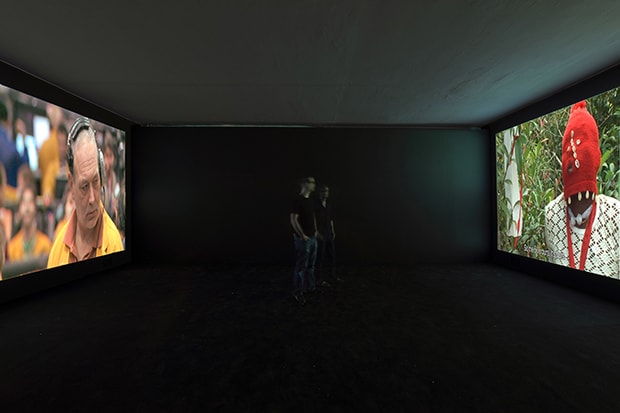
Neither video occupies its own space and time, where it might receive undivided attention from the viewer. Rather than screening both videos side by side on different monitors or on a split screen where they might share the viewer’s sightline, Boulos places the screens across from one another so that both videos cannot be watched at once. Physically caught between both screens, the viewers must negotiate how they will divide their attentions between each video and what it represents. By mediating the meaning of both documentaries through the viewer’s position, Boulos not only makes the viewer a third-party witness to these two stories of oil, but also an accomplice.
The images of the stock traders are for the most part smaller than life-size, while the interviews with guerrilla fighters are at closer range and larger. While Boulos physically places the viewer in the middle of both stories, the piece refuses any promise of impartiality. The viewer is pulled in by the direct address of the MEND members, in contrast with the diverted gazes and hectic flurry of stock traders jumping up and down to sell and buy financial products. The viewer’s decision of who to listen to, what position to take, and with whom to rest his or her sympathies is coerced through the piece’s production and exhibition. Boulos’s filmmaking choices, and the title’s reference, plainly reveal that his investments and alliances rest with MEND.
Single-channel view of Mark Boulos’s installation, All That Is Solid Melts into Air (2008). Courtesy the artist, copyright the artist.
Describing himself as a Marxist filmmaker sympathetic to revolutionary movements and resistance, Boulos is critical of “liberal human rights journalism, which sympathizes with third world people as long as they remain victims, and at best, victims of themselves.”49 Based in filmmaking methods that challenge the use of documentary as an unbiased journalistic form of truth telling, and that constantly test “the limits of my own beliefs as well,” Boulos considers his work “as much about challenging my own ideas and seeing what I honestly believe, as it is about planning a film.”50 In her theorization of the erotic, Lorde emphasizes the importance of recognizing one’s own position and how this is shaped by and informs one’s personal affiliations and alliances.51
The fourth piece that provides insight into New Frontier’s investments is RAW/WAR, a transmedia project by American film director and artist Lynn Hershman Leeson (Conceiving Ada [1997], Teknolust [2002], Strange Culture [2007]) that explicitly addresses the gaps in feminist art histories.52 RAW/WAR was developed in conjunction with Leeson’s feature-length documentary film, !Women Art Revolution (2010), which traces the emergence of a 1960s feminist art movement in the United States that was founded as a response to the exclusion of female artists from museum collections, exhibitions, art journals, and the archive. The documentary draws from Leeson’s personal perspective as an activist and artist, and includes interviews with feminist artists, curators, activists, and scholars alongside rarely seen archival film and video footage.
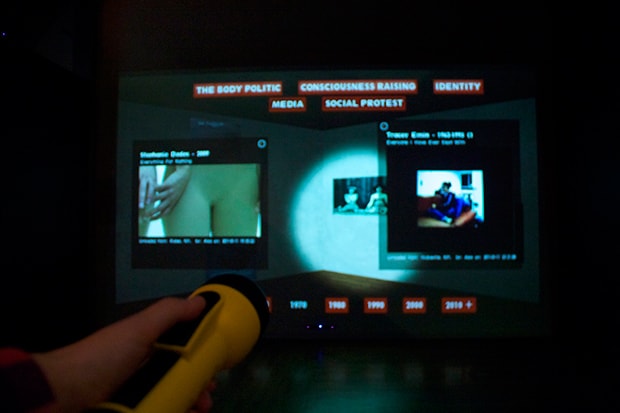
RAW/WAR is an online, community-curated initiative that connects feminist artists globally, and is sustained by people uploading their contributions to feminist art histories, including documentation of art works and performances, interviews, archival footage, and transcripts. Illuminating the things lost and left behind by the “edit” in documentaries, museum collections, history textbooks, and art journals, RAW/WAR makes available full-length interviews, transcripts, and performances in their entirety so new histories can be told collaboratively through the use of digital and social-networking technologies. The interactive exhibition of RAW/WAR at New Frontier presented the opportunity to navigate the interface of the video archive, including more than 260 contemporary female artists and 430 works online, including films by Yvonne Rainer, Yayoi Kusama, Dara Birnbaum, Martha Rosler, Rebecca Horn, and Trinh Minh ha. The deliberately social atmosphere of New Frontier encouraged individual and collective engagements with these archives on a large screen. Participants used virtual flashlights to serendipitously excavate and explore the unknowns of the archive, scrolling through the site’s organizational filters, categorized by decades from the 1960s through the present under five subject headings: “body politic,” “consciousness raising,” “social protest,” “identity,” and “media.” Interrupting practices of erasures, RAW/WAR reclaims authorship and access by engaging in a liberatory model for narrating multiple histories of social, political, and artistic movements.
Frilot’s Curatorial Work as Artistic Practice
- Gwenaelle Gobe, “Miwa Matreyek: Illusion and Non-Illusion,” L.A. Record, 9 Aug. 2010, accessed on 27 Oct. 2011. [↩]
- Gobe 2010. [↩]
- Lorde 1984: 54. [↩]
- Miwa Matreyek, quoted in Gobe 2010. [↩]
- Lynette Wallworth, quoted in Catherine Wilson, “Review of Theatre de l’Archeveche, International Festival d’Art Lyrique, Aix-en-Provence, 27 June – 23 July 2008,” Interface: Visual Art Exhibitions and Events with a Platform for Critical Writing, n.d., accessed on 27 Oct. 2011. [↩]
- Wilson n.d. [↩]
- Laura U. Marks, Touch: Sensuous Theory and Multisensory Media (Minneapolis: U of Minnesota P, 2002), 18. [↩]
- Marks 2002: 20. [↩]
- Karl Lydén, “Part of the Process–Mark Boulos: Ecstasy, Militancy, and Marxist Filmmaking,” Mousse Contemporary Art Magazine, 24 (Jun. 2010), accessed 27 Oct. 2011. [↩]
- Mark Boulos, quoted in Lydén 2010. [↩]
- Lorde 1984: 57. [↩]
- RAW/WAR was made in collaboration with Alexandra Chowaniec, Gian Pablo Villamil, Stacy Duda, and Paul Paradiso. [↩]
